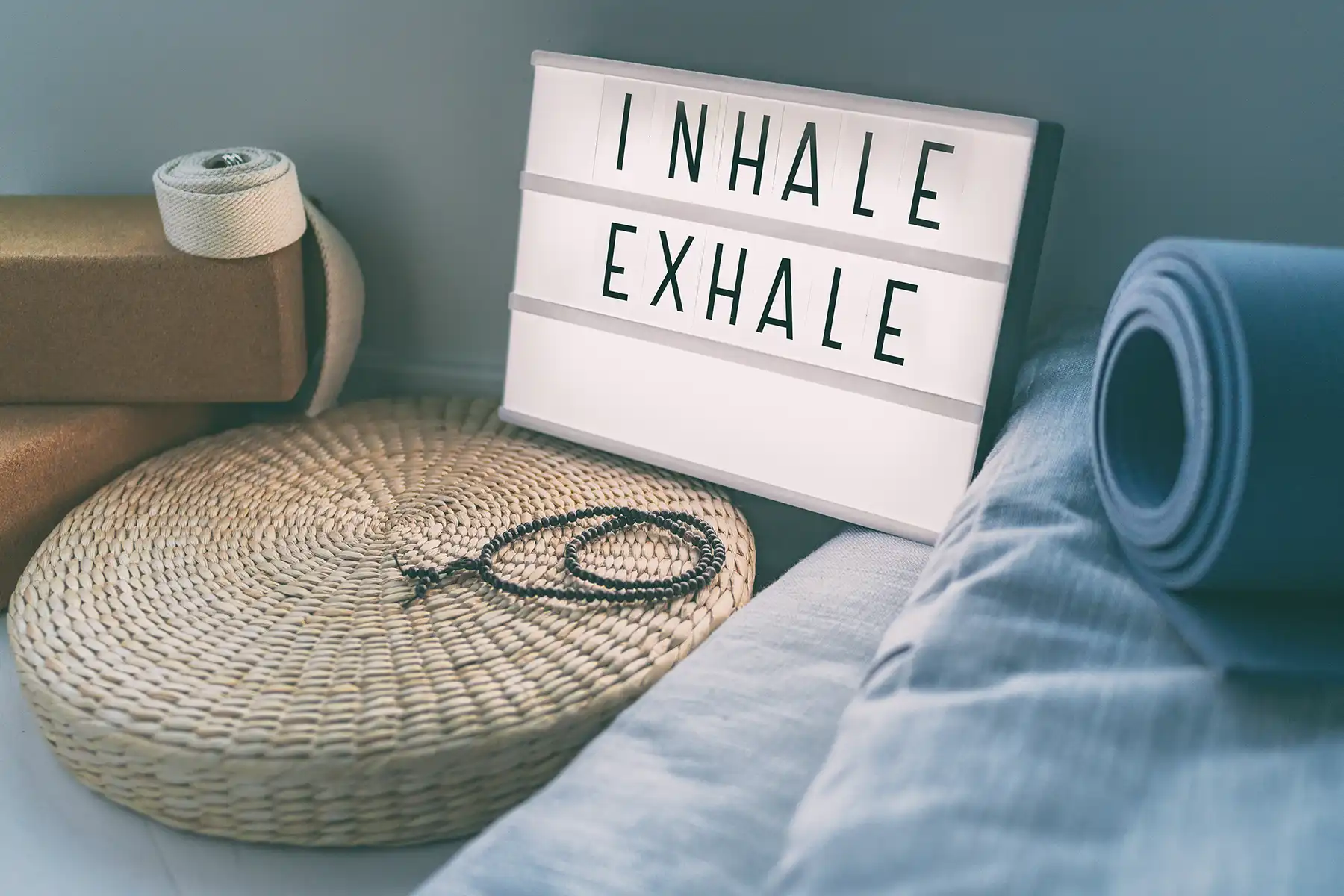9 Breathing Exercises for Stress and Anxiety Relief

Breathing exercises are well-known methods for soothing the mind and relieving stress, but have you ever wondered how exactly they work?
Studies have shown that taking deep breaths can reduce common bodily responses that make us feel stressed, like a rapid heartbeat and shortness of breath.
Regular practice can also have other health benefits, including promoting better sleep and immune system function.
In this article, we’ll take a closer look at why deep breathing can promote relaxation and explore nine techniques you can use to reduce stress and anxiety to enhance your well-being.
How Do Breathing Exercises Reduce Stress and Anxiety?
Breathing exercises can significantly impact the two main parts of the body’s nervous system, called the sympathetic nervous system (SNS) and the parasympathetic nervous system (PNS).
The SNS — often called the “fight or flight” system — prepares the body to respond to perceived threats by increasing the heart rate and releasing stress hormones (cortisol).
On the other hand, the PNS — known as the “rest and digest” system — promotes relaxation and healing by slowing the heart rate, decreasing blood pressure, and reducing cortisol.
Practicing a breathing exercise activates the PNS, prompting the brain to signal the body to relax. This process offers immediate stress and anxiety relief, cultivating a sense of calm.
9 Breathing Techniques for Anxiety and Stress Relief
Belly breathing
Belly breathing — or abdominal breathing —focuses on deep, diaphragmatic breaths to maximize oxygen intake.
This process naturally promotes a feeling of calmness by stimulating the PNS and decreasing heart rate.
Method
- Lie down or sit comfortably, placing one hand on your belly and the other on your upper chest.
- Breathe deeply through your nose, ensuring your belly rises more than your chest does.
- Exhale slowly through your mouth or nose, whichever feels more comfortable, pressing gently on your belly to expel all the air.
- Repeat this process for 5-10 minutes, focusing on the rise and fall of your belly.
4-7-8 breathing method
This method focuses on concentration and briefly reducing oxygen intake to relax the body.
Practicing the 4-7-8 breathing technique can also help you manage emotional responses more effectively and improve your sleep quality when done regularly.
Method
- Sit or lie in a comfortable position and empty your lungs of air.
- Breathe in quietly through your nose for 4 seconds.
- Hold your breath for a count of 7 seconds.
- Exhale forcefully through your mouth, pursing your lips, and making a "whoosh" sound for 8 seconds.
- Repeat the cycle up to 4 times.
Lion’s breath
Inhaling through the nose and exhaling forcefully through the mouth can release facial and chest muscle tension.
This can help reduce stress, clear the mind, and provide a burst of energy to combat post-anxiety fatigue.
Method
- Get into a comfortable seated position, crossing your legs or sitting on a chair.
- Inhale deeply through your nose.
- Open your mouth wide, extend your tongue toward your chin, and exhale forcefully with a "ha" sound.
- Repeat several times.
Humming bee breath
When practicing this breathing method, the sound you make creates a soothing effect on the mind and body, reducing stress, tension, and anxiety.
The vibration from the humming can also help reduce external distractions to improve your focus.
Method
- Sit comfortably and close your eyes. Place your index fingers on your ears.
- Take a deep breath through your nose.
- As you exhale, gently press your fingers into your ears and make a loud humming sound like a bee.
- Repeat 5-7 times.
Sitali breath
This technique involves inhaling through a curled tongue and exhaling through the nose, cooling the body and calming the mind.
When done correctly, sitali breaths can soothe the nervous system and provide mental clarity, especially after physical exertion.
Method
- Sit in a comfortable position with your eyes closed.
- Stick out your tongue and curl the sides upward into a tube.
- Inhale deeply and smoothly through your tongue tube.
- Withdraw your tongue, close your mouth, and exhale through your nose.
- Repeat for up to 5 minutes.
Alternate nostril breathing
Alternating between nostrils when breathing can help balance the brain’s right and left sides, fostering a sense of calm.
This technique can also enhance respiratory functions and improve mental clarity by reducing stress and anxiety.
Method
- Sit in a comfortable position with your legs crossed.
- Place your left hand on your knee and your right thumb on your right nostril, closing it.
- Inhale deeply through your left nostril.
- Close your left nostril with your ring finger, then open your right nostril, and exhale.
- Inhale through the right nostril, close it, then open the left nostril, and exhale.
- Continue this pattern for 5-10 minutes.
Resonant breathing
Breathing at a slightly quicker rate is believed to synchronize the heart rate and reduce blood pressure, fostering deep relaxation.
This can help reduce stress by improving your mood and enhancing cognitive performance.
Method
- Lie down or sit in a comfortable position.
- Inhale slowly and steadily through your nose for 5 seconds.
- Exhale slowly and steadily through your nose for 5 seconds.
- Continue for several minutes, aiming for a rate of 5-6 breaths per minute.
Pursed lip breathing
Practicing the pursed lip breathing pattern can help slow down the pace of your breaths to enhance their effectiveness.
This can improve your overall breath control, reduce shortness of breath associated with anxiety, and help you manage panic attacks.
Method
- Sit or stand in a comfortable position.
- Inhale slowly through your nose for about 2 seconds.
- Pucker your lips as if you’re going to whistle.
- Exhale slowly and gently through your pursed lips for about 4 seconds.
- Repeat this process.
Box breathing
Box breathing is a technique used to control your breaths and reset the nervous system to induce a state of calm.
This can promote relaxation and enhance your focus to help you better manage emotional responses like stress and anxiety.
Method
- Sit upright in a comfortable chair with your feet flat on the ground.
- Close your eyes and take a few deep breaths to prepare.
- Inhale through your nose while counting to 4.
- Hold your breath for another count of 4.
- Repeat the cycle for 4 minutes or until you feel calmer.
Tips for Incorporating Relaxing Breathing Techniques into Your Routine
Consistency is key
Incorporating breathing techniques into your daily routine may seem overwhelming, but you can still reap the benefits by practicing for a few minutes each day.
Even a short period of daily focused breathing can have a noticeable impact on your stress and anxiety levels, providing an almost instant sense of relief.
You can increase the length of these sessions over time, as you become more comfortable with the practice.
Regular practice also helps you establish a routine and reinforces the habit of daily exercise.
To stick to a regular practice schedule, set reminders for yourself to ensure you work on your breathing consistently.
Create a comfortable environment to practice in
Before you start practicing, find a quiet, comfortable place where you can sit or lie down without interruptions.
This can be a designated corner in your room, a comfortable chair, or even a spot in your garden.
The goal is to signal to your body that you are in a safe environment where it can start to relax.
Be patient
It can take a few weeks to become comfortable with practicing breathing exercises and notice their benefits.
Some days you may also find it more challenging to focus on your breathing, but the key is to remain patient.
The body needs some time to adjust to practice, so be kind to yourself during the initial phases of incorporating breathing exercises into your routine.
Where Can You Learn More About Healthy Wellness Habits?
If you’re looking for holistic ways to improve your quality of life or want to know more about breathing and other relaxation techniques that reduce stress, LifeMD is here to help.
LifeMD can connect you to a team of medical professionals who can provide information and guidance on how to create an optimal sleep environment through healthy habits.
Make your appointment today to get started.
More articles like this
Feel better with LifeMD.
Your doctor is online and ready to see you.
Join LifeMD today and experience amazing healthcare, discounted labs and prescription medications... plus around-the-clock access to medical guidance.



